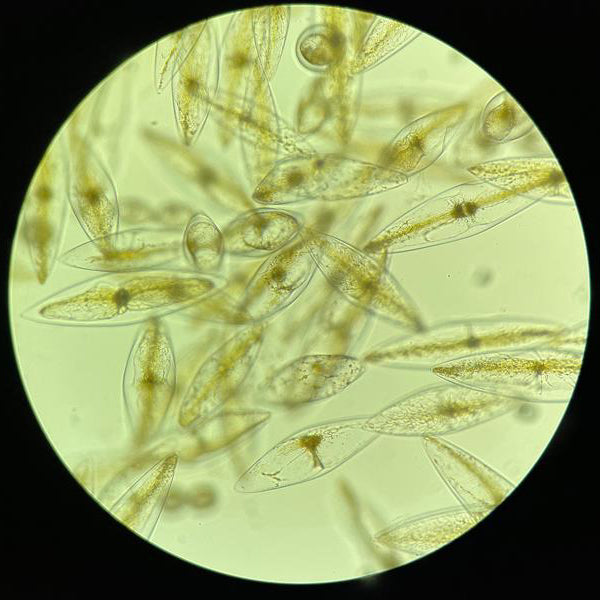
Microalgae: The Marvels of Asexual Reproduction and Immortal Cells
All the microaglae we grow came from one plankton cell isolated off the coast of San Diego in 2009. From this single plankton cell, we have grown everything we use for our skin care products.
In the vast expanse of the world's oceans resides an extraordinary organism that captivates scientists and ocean enthusiasts: Pyrocystis fusiformis, bioluminescent microalgae. Also referred to as phytoplankton. Some microalgae possess a fascinating ability to reproduce through asexual means, giving rise to an eternal lineage of cells.

P fusiformis is known for their stunning display of bioluminescence. When agitated or disturbed, these tiny unicellular cells emit a soft blue-green glow, creating breathtaking displays of light in the ocean waters. However, beneath its mesmerizing exterior lies a truly remarkable mode of reproduction.

Asexual Reproduction: The Key to Immortality: PyroDinos rely predominantly on asexual reproduction, a process that enables it to perpetuate its lineage indefinitely. This form of reproduction does not involve the exchange of genetic material but instead relies on the division of a single parent cell into two daughter cells.

Binary Fission: Dividing and Multiplying: The primary method of asexual reproduction in Pyrocystis fusiformis is binary fission. The process begins when the parent cell undergoes mitosis after reaching a specific size and physiological state. During mitosis, the genetic material within the cell is duplicated, and the organelles divide equally between the two resulting daughter cells. Eventually, the parent cell splits into two separate entities, each with the complete genetic information necessary to function autonomously.
One of the most intriguing aspects of microalgae asexual reproduction is that the daughter cells can independently survive. Once the parent cell divides, the two daughter cells can live and reproduce, each continuing their parent's lineage. This process can continue indefinitely, resulting in an immortal population of genetically identical cells.

PyroSkinCare relies on this immortal concept to continually propagate our microaglae cell cultures. By continuously adding nutrient-enriched purified seawater (DinoNutrients) and providing natural and artificial light, PyroSkinCare can produce large volumes of microaglae in a short period of time.

The Significance of Immortal Cells: The concept of immortal cells, as observed in our microalgae, carries profound implications. While most organisms eventually succumb to aging and mortality, These cells defy this fundamental limitation by continuously producing genetically identical offspring. The immortality of these cells allows them to persist in their environment, maintaining stability and perpetuating their species over long periods.
Microalgae produce valuable compounds that have existed for millions of years. Microalgal compounds can be used as an anti-aging cream, sun protection products, skin-whitening agents. Microalgae are conventional producers of high value bioactive products.

Adaptation and Environmental Resilience: Our microaglae's ability to reproduce asexually and maintain an immortal lineage has likely played a crucial role in their adaptation and resilience to various environmental conditions. By avoiding the need for sexual reproduction, which requires the presence of compatible mates, P fusiformis can quickly and efficiently reproduce, ensuring the survival of its genetic information in response to changing environmental pressures.
These remarkable cells give us a glimpse into immortal cell wonders. This bioluminescent phytoplankton perpetuates its lineage indefinitely through binary fission, resulting in a population of genetically identical, immortal cells. This unique reproductive strategy contributes to the adaptability and resilience of our microalgae, enabling them to thrive in diverse oceanic environments.
